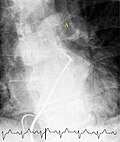Pulmonary angiography
Pulmonary Angiography is a medical imaging procedure used to visualize the pulmonary arteries in the lungs. It is primarily used to diagnose pulmonary embolism, a condition characterized by blockage in the lung arteries.
Procedure[edit]
The procedure involves the insertion of a catheter into a blood vessel in the groin or arm. This catheter is then guided to the pulmonary artery. A contrast agent is then injected through the catheter, and X-ray images are taken to visualize the blood flow in the lungs.
Indications[edit]
Pulmonary angiography is indicated in patients with suspected pulmonary embolism, especially when other diagnostic tests are inconclusive. It may also be used to evaluate other conditions affecting the pulmonary arteries, such as pulmonary hypertension or pulmonary arteriovenous malformation.
Risks[edit]
As with any invasive procedure, pulmonary angiography carries certain risks. These include bleeding at the catheter insertion site, allergic reaction to the contrast agent, and damage to the blood vessels. In rare cases, the procedure can cause kidney damage or a serious allergic reaction.
Alternatives[edit]
While pulmonary angiography is considered the gold standard for diagnosing pulmonary embolism, less invasive tests are often used first. These include computed tomography pulmonary angiography (CTPA) and ventilation/perfusion scan (V/Q scan).
See also[edit]
This radiology related article is a stub. You can help WikiMD by expanding it.
Ad. Transform your life with W8MD's Budget GLP-1 injections from $75


W8MD offers a medical weight loss program to lose weight in Philadelphia. Our physician-supervised medical weight loss provides:
- Weight loss injections in NYC (generic and brand names):
- Zepbound / Mounjaro, Wegovy / Ozempic, Saxenda
- Most insurances accepted or discounted self-pay rates. We will obtain insurance prior authorizations if needed.
- Generic GLP1 weight loss injections from $75 for the starting dose.
- Also offer prescription weight loss medications including Phentermine, Qsymia, Diethylpropion, Contrave etc.
NYC weight loss doctor appointmentsNYC weight loss doctor appointments
Start your NYC weight loss journey today at our NYC medical weight loss and Philadelphia medical weight loss clinics.
- Call 718-946-5500 to lose weight in NYC or for medical weight loss in Philadelphia 215-676-2334.
- Tags:NYC medical weight loss, Philadelphia lose weight Zepbound NYC, Budget GLP1 weight loss injections, Wegovy Philadelphia, Wegovy NYC, Philadelphia medical weight loss, Brookly weight loss and Wegovy NYC
|
WikiMD's Wellness Encyclopedia |
| Let Food Be Thy Medicine Medicine Thy Food - Hippocrates |
Medical Disclaimer: WikiMD is not a substitute for professional medical advice. The information on WikiMD is provided as an information resource only, may be incorrect, outdated or misleading, and is not to be used or relied on for any diagnostic or treatment purposes. Please consult your health care provider before making any healthcare decisions or for guidance about a specific medical condition. WikiMD expressly disclaims responsibility, and shall have no liability, for any damages, loss, injury, or liability whatsoever suffered as a result of your reliance on the information contained in this site. By visiting this site you agree to the foregoing terms and conditions, which may from time to time be changed or supplemented by WikiMD. If you do not agree to the foregoing terms and conditions, you should not enter or use this site. See full disclaimer.
Credits:Most images are courtesy of Wikimedia commons, and templates, categories Wikipedia, licensed under CC BY SA or similar.
Translate this page: - East Asian
中文,
日本,
한국어,
South Asian
हिन्दी,
தமிழ்,
తెలుగు,
Urdu,
ಕನ್ನಡ,
Southeast Asian
Indonesian,
Vietnamese,
Thai,
မြန်မာဘာသာ,
বাংলা
European
español,
Deutsch,
français,
Greek,
português do Brasil,
polski,
română,
русский,
Nederlands,
norsk,
svenska,
suomi,
Italian
Middle Eastern & African
عربى,
Turkish,
Persian,
Hebrew,
Afrikaans,
isiZulu,
Kiswahili,
Other
Bulgarian,
Hungarian,
Czech,
Swedish,
മലയാളം,
मराठी,
ਪੰਜਾਬੀ,
ગુજરાતી,
Portuguese,
Ukrainian
